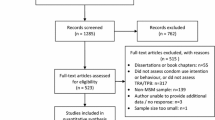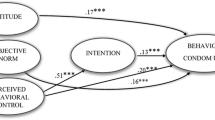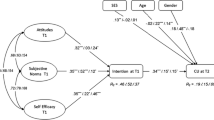Abstract
Using the Theory of Planned Behaviour (Ajzen, 1988) as a conceptual framework, 705 secondary school students were surveyed to identify their intentions to use birth control pills, condoms, and birth control pills in combination with condoms. Hierarchical multiple regression revealed that the theory explained between 23.5% and 45.8% of the variance in intentions. Variables external to the model such as past use, age, and ethnicity exhibited some independent effects. Attitudes were consistently predictive of intentions to use condoms, pills, and condoms in combination with pills for both male and female students. However, there were differences by gender in the degree to which subjective norms and perceived behavioural control predicted intentions. The findings suggest that programs should focus on: creation of positive attitudes regarding birth control pills and condoms; targeting important social influences, particularly regarding males’ use of condoms; and developing strategies to increase students’ control over the use of condoms.
Résumé
La théorie du comportement axé sur un objectif (Ajzen, 1988) a servi de cadre de travail conceptuel pour mener un sondage auprès de 705 étudiants à l’école secondaire visant à connaître leurs intentions concernant l’utilisation de la pilule anticonceptionnelle, du condom ou des deux méthodes combinées. L’analyse de variance avec régression hiérarchique a révélé que la théorie expliquait entre 23,5 % et 45,8 % de la variance dans les intentions. Les variables extérieures au modèle comme l’utilisation qu’ils en ont fait dans le passé, l’âge et le groupe ethnique ont révélé des effets indépendants. Les attitudes étaient prévisibles tant chez les filles que chez les garçons quant à l’intention d’utiliser soit le condom, la pilule anticonceptionnelle ou bien une combinaison des deux. Cependant, on a noté des différences selon le sexe concernant la subjectivité des normes et la perception de contrôle des comportements des intentions prévues. Les conclusions indiquent que les programmes devraient s’attarder à: développer des attitudes positives au sujet de la pilule anticonceptionnelle et du condom; viser les influences sociales importantes, en particulier en ce qui a trait à l’utilisation du condom chez les hommes; et mettre au point des stratégies pour accroître la maîtrise des étudiants pour ce qui est de l’utilisation du condom.
Similar content being viewed by others
References
King A, Beazley R, Warren W, et al. Canada, Youth, and AIDS Study. Social Program Evaluation Group, Queen’s University, Kingston, ON, 1988.
Health Canada. Sexual Risk Behaviours of Canadians. Bureau of HIV/AIDS and STD Epi Update Series, Ottawa, ON: LCDC, 1997.
U.S. Department of Health and Human Services. Trends in sexual risk behaviour among high school students–United States, 1991–1997. Morbidity and Mortality Weekly Report 1998;47(36):749–52.
Thomas BH, DiCenso A, Griffith L. Adolescent sexual behaviour: Results from an Ontario sample. Part 1: Adolescent sexual activity. Can J Public Health 1998;89(2):90–93.
Borges SS, Hollett RG, Down S, et al. AIDS, sexually transmitted diseases, and birth control: Knowledge, attitudes and behaviours among grade 11 students. PHERO 1992;3(17):293–96.
Ramsum DL, Marion SA, Mathias RG. Changes in university students’ AIDS-related knowledge, attitudes, and behaviours, 1988 and 1992. Can J Public Health 1993;84(4):275–78.
Svenson LW, Varnhagen CK. Knowledge, attitudes and behaviours related to AIDS among first-year university students. Can J Public Health 1990;81(2):139–40.
Svenson LW, Varnhagen CK, Godin AM, Salmon TL. Rural high school students’ knowledge, attitudes and behaviours related to sexually transmitted diseases. Can J Public Health 1992;83(4):260–63.
Richardson HRL, Beazley RP, Delaney ME, et al. Factors influencing condom use among students attending high school in Nova Scotia. Can J Human Sexuality 1997;6(3):185–96.
Thomas BH, DiCenso A, Griffith L. Adolescent sexual behaviour: Results from an Ontario sample Part II: Adolescent use of protection. Can J Public Health 1998;89(2):94–97.
Baffi CR, Schroeder KK, Redican KJ, et al. Factors influencing selected heterosexual male college students’ condom use. J Am Coll Health 1989;38:137–41.
Grimley DM, Riley GE, Bellis JM, et al. Assessing the stages of change and decisionmaking for contraceptive use for the prevention of pregnancy, sexually transmitted diseases, and acquired immunodeficiency syndrome. Health Educ Q 1993;20(4):455–70.
Weisman CS, Plichta S, Nathanson CA, et al. Consistency of condom use for disease prevention among adolescent users of oral contraceptives. Fam Plann Perspect 1991;23(2):71–74.
Maticka-Tyndale E. Sexual scripts and AIDS prevention: Variations in adherence to safer sex guidelines by heterosexual adolescents. J Sex Res 1991;28:45–66.
Frank J. 15 Years of AIDS in Canada. Canadian Social Trends 1996;41:4–10. Ottawa, ON: Statistics Canada.
Wadhera S, Millar W. Trends in births to teenagers in Ontario, 1974–1994. Health Rep 1997;9(3):9–17.
Ajzen I. Attitudes, Personality, and Behaviour. Bristol, Great Britain: Open University Press, 1988.
Ajzen I, Fishbein M. Understanding Attitudes and Predicting Social Behaviour. Englewood Cliffs, NJ: Prentice-Hall, 1980.
Adler NE, Kegles SM, Irwin CE, et al. Adolescent contraceptive behaviour and assessment of decision-making. J Pediatr 1990;116:463–70.
Jaccard JJ, Davidson AR. Toward an understanding of family planning behaviours: An initial investigation. J Appl Soc Psychol 1972;2:228–35.
Werner PD, Middlestadt SE. Factors in the use of oral contraceptives by young women. J Appl Soc Psychol 1979;9(6):537–47.
Basen-Engquist K, Parcel GS. Attitudes, norms, and self-efficacy: A model of adolescents’ HIV-related sexual risk behaviour. Health Educ Q 1992;19(2):263–77.
Ewald BM, Roberts CS. Contraceptive behaviour in college-age males related to Fishbein model. Adv Nurs Sci 1985;7(3):63–69.
Fisher WA. Predicting contraceptive behaviour among university men: The role of emotions and behavioural intentions. J Appl Soc Psychol 1984;14(2):104–23.
Jemmott LS, Jemmott JB. Applying the theory of reasoned action to AIDS risk behaviour: Condom use among Black women. Nurs Res 1991;40(4):228–34.
Jemmott JB, Jemmott LS, Hacker CI. Predicting intentions to use condoms among African American adolescents: The theory of planned behaviour as a model of HIV risk-associated behaviour. Ethn Dis 1992;2:371–80.
Lavoie M, Godin G. Correlates of intention to use condoms among auto mechanic students. Health Educ Res 1991;6(3):313–16.
Rannie KE, Craig DM. Adolescent females’ attitudes, subjective norms, perceived behavioural control and intentions to use latex condoms. Public Health Nurs 1993;14(1):51–57.
Reinecke J, Schmidt P, Ajzen I. Application of the theory of planned behaviour to adolescents’ condom use: A panel study. J Appl Soc Psychol 1996;26(9):749–72.
Wulfert E, Wan K. Safer sex intentions and condom use viewed from a health belief, reasoned action, and social cognitive perspective. J Sex Res 1995;32(4):299–311.
Reinecke J, Schmidt P, Ajzen I. Birth control versus AIDS prevention: A hierarchical model of condom use among young people. J Appl Soc Psychol 1997;27(9):743–59.
Aseltine RH. Pathways linking parental divorce with adolescent depression. J Health Soc Behav 1996;37(2):133–48.
Tabachnick BG, Fidell LS. Using Multivariate Statistics. New York: Harper Collins, 1996.
Author information
Authors and Affiliations
Corresponding author
Additional information
This study was funded by The National Health Research and Development Program of Health Canada, Project #6606-5631-201. The study was a project of the North York Community Health Promotion Research Unit. Kenneth Allison is supported by a Career Scientist award from the Ontario Ministry of Health.
Rights and permissions
About this article
Cite this article
Craig, D.M., Wade, K.E., Allison, K.R. et al. Factors Predictive of Adolescents’ Intentions to Use Birth Control Pills, Condoms, and Birth Control Pills in Combination with Condoms. Can J Public Health 91, 361–365 (2000). https://doi.org/10.1007/BF03404808
Received:
Accepted:
Published:
Issue Date:
DOI: https://doi.org/10.1007/BF03404808




